The Hidden Link: ISA, Post-Concussion Syndrome, and Visual Sensitivity

Post-concussion syndrome (PCS) presents a complex array of symptoms that can significantly impact a patient's life. While common symptoms like headaches, dizziness, and cognitive difficulties are widely recognized, the influence of individual structural variations, particularly the Innate Spinal Anatomical (ISA) typology, on visual sensitivity and balance post-concussion remains largely unexplored. This article delves into this intriguing connection, proposing that disruptions in the ISA may contribute to visual dependence and heightened sensitivity in individuals recovering from concussions.
Defining ISA for the Physical Therapist
The InnSpinal Anatomical (ISA) classification system, developed by physical therapist Bill Hartman, categorizes individuals into two primary archetypes – Wide ISA and Narrow ISA – based on their skeletal structure and associated postural tendencies. It's not about labeling patients but about understanding how their inherent anatomical structure influences their movement strategies, muscle imbalances, and overall function.
Wide ISA: Characterized by a wider pelvis, shorter leg length relative to the torso, and a tendency for an anterior pelvic tilt, increased femoral anteversion, and foot pronation. These individuals often present with limitations in hip extension, internal rotation, and dorsiflexion.
Narrow ISA: Characterized by a narrower pelvis, longer leg length relative to the torso, a tendency for a posterior pelvic tilt, decreased femoral anteversion, and foot supination. These individuals often present with hip flexion, external rotation, and plantarflexion limitations.
ISA and the Sensory Landscape
These ISA variations can influence muscle imbalances, movement patterns, and how we perceive our bodies in space (proprioception). We hypothesize that when a concussion disrupts the delicate balance of the vestibular system, responsible for balance and spatial orientation, individuals with ISA variations may experience a heightened reliance on visual cues for stability. This is because their inherent proprioceptive feedback, already influenced by their ISA archetype, may be further compromised.
The Visual Component: ISA's Potential Impact
Interestingly, the impact of ISA may extend beyond proprioception to the visual system itself. While research in this area is nascent, it's conceivable that:
Cranial Adaptations: Variations in skull morphology associated with Wide or Narrow ISA could subtly influence the positioning and movement of the eyes. For instance, a broader cranial base might correlate with a wider interpupillary distance and a tendency for exophoria (outward eye drift).
Fascial Connections: The intricate fascia network throughout the body could transmit tension patterns stemming from ISA variations to the muscles surrounding the eyes, potentially affecting their function. This could manifest as difficulty with convergence, eye tracking, or visual field limitations.
These factors may contribute to visual sensitivity, difficulties with eye tracking, and challenges with depth perception, further complicating recovery from a concussion.
Clinical Implications: A Holistic Approach
Recognizing the potential influence of ISA on visual sensitivity and balance in PCS patients opens up new avenues for assessment and treatment.
Comprehensive Evaluation: Clinicians should incorporate a thorough postural and visual assessment, considering the patient's ISA archetype, to identify potential contributing factors to their symptoms.
Targeted Interventions: Treatment plans should address the vestibular dysfunction, any underlying muscle imbalances, and movement limitations associated with the ISA. This may involve:
Manual therapy to release fascial restrictions and improve musculoskeletal alignment.
Vestibular rehabilitation to retrain the balance system.
Visual exercises to enhance eye tracking, focus, and coordination.
Patient education empowers individuals to understand their condition and actively participate in recovery.
Specific Examples of ISA and Visual/Balance Disturbances
Wide ISA: May present with convergence insufficiency, exophoria, difficulty with depth perception, increased reliance on visual cues for balance, challenges with single-leg stance, and oversensitivity to head movements.
Narrow ISA: May present with esophoria, reduced peripheral vision, eye fatigue, difficulty with backward gait, reduced adaptability to uneven surfaces, and delayed balance reactions.
Conclusion
By acknowledging the intricate interplay between ISA, post-concussion syndrome, and visual sensitivity, we can move towards a more holistic and individualized approach to patient care. Further research is needed to elucidate these connections fully, but this emerging perspective holds promise for improving outcomes and enhancing the quality of life for individuals recovering from concussions. By addressing the vestibular system and the musculoskeletal and visual components, clinicians can unlock new pathways for healing and recovery.
References:
McCrory P, Meeuwisse W, Dvorak J, et al. Consensus statement on concussion in sport—the 5th international conference on concussion in sport held in Berlin, October 2016. Br J Sports Med. 2017;51(11):838-847.
Hartman B. The ISA Manual: A Clinician's Guide to Innate Spinal Anatomical Variation. Indianapolis: The Institute of Clinical Excellence; 2015.
Cupples Z. Infrasternal Angle Treatment 101. [Internet]. Zac Cupples. 2023 [cited 2025 Jan 15]. Available from: https://zaccupples.com/isa/
Myers TW. Anatomy Trains: Myofascial Meridians for Manual and Movement Therapists. 3rd ed. Edinburgh: Churchill Livingstone; 2014.
Herdman SJ. Vestibular Rehabilitation. 4th ed. Philadelphia: F.A. Davis; 2013.
Schleip R, Findley TW, Chaitow L, Huijing PA. Fascia: The Tensional Network of the Human Body. Edinburgh: Churchill Livingstone; 2012.
Vestibular Disorders Association. [Internet]. Portland (OR): Vestibular Disorders Association; c1995-2025. Available from: https://vestibular.org/



